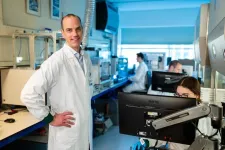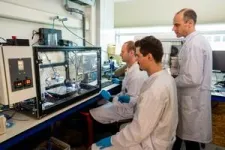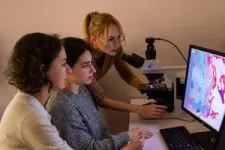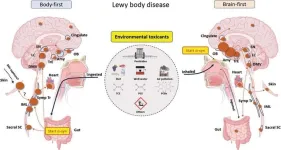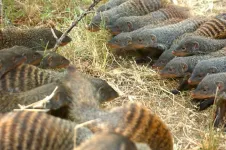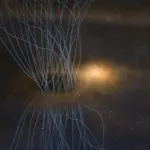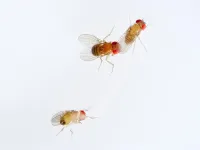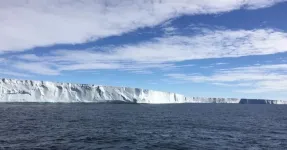(Press-News.org) Can Jos Malda crack the code of cartilage?
In our aging society, healing joint problems is becoming increasingly important. To do this, cartilage damage must become repairable. But so far it has proven impossible to recreate the intricate internal structure of cartilage. Professor Jos Malda has now received an ERC Advanced grant of €2.5 million to crack that code.
Bringing biology and technology together
Throughout his career, Jos Malda has been concerned with the interface between biology and technology. It took him from studying Bioprocess Engineering in Wageningen to a professorship of Biofabrication in Translational Regenerative Medicine in Utrecht. Here, at the Regenerative Medicine Center Utrecht, he has been focusing on printing and regenerating cells and tissues for years. Jos: 'It started with cartilage, because it seemed relatively simple, without blood vessels and nerves. But it turns out to be very complicated, because it has a special structure.'
Cartilage is a challenging tissue due to its arched structure
Cartilage contains few cells, but lots of collagen in an arcuate structure. “These arches provide strength and can withstand a lot, just like similar shapes in old bridges or the famous buildings of Antoni Gaudí,” says Jos. Because cartilage has few cells, repair via the body's own processes is difficult, and the solution mainly lies in being able to reshape the cartilage arches. 'There are ways to repair cartilage, but they leave the collagen in a random orientation. This does not last as long and ensures that there is always a seam with the healthy tissue.'
A prestigious grant to understand cartilage
The 2.5 million euros that Jos Malda is now receiving from the European Research Council, the largest individual grant in Europe, is intended to find out once and for all how these cartilage arches arise, and how we can recreate it for regenerative treatments. 'The great thing about this ERC Advanced grant is that it gives a lot of freedom. We have a thorough plan, but if the results show that we need to adjust our approach, then we can,” Jos beams.
Learning from models and animals
One of the first steps in the project will be to create a cartilage 'organ-on-a-chip' model. This is a small model in which pieces of cartilage can be studied in great detail. Jos: 'We can make very small adjustments in such a model, for example in altering mechanical loading or by adding certain substances. How the tissue responds teaches us step by step what is important for the development of the cartilage.'
Another important phase is at the Faculty of Veterinary Medicine at Utrecht University. ‘I have been collecting cartilage from joints of various mammals for over fifteen years,’ Jos explains. 'It started with horses and dogs, but after I had the opportunity to examine an elephant that died in a zoo, I started looking more broadly. Now I have broad selection in the drawer, from giraffes and kangaroos to orcas and sperm whales.”
Each animal is a puzzle piece
That collection of animals – all accidental deaths – now turns out to be a gold mine. 'We can link the difference in cartilage to a different lifestyle. Animals that swim in the water experience a completely different load than walking land animals, and the joints and cartilage show this. Marine mammals, for example, lack those characteristic arches. This indicates that the forces that occur during walking may play a role in the development of the cartilage. This way we keep puzzling further towards the answer.'
The best conditions for arches
Jos links all the knowledge gained from research on other mammals and the models to his expertise in 3D bioprinting – printing living cells and tissues. 'We can already do a lot with our bioprinters. But we will have to combine the technological side of printing arches with biological signals to ensure that such a print is ultimately successful and integrates well into the rest of the cartilage.'
A vision of a flexible joint
The ultimate goal of this knowledge is to create better treatments for humans and animals. “If we can recreate the cartilage better and have repairs properly integrated into the rest of the joint, the joints will remain healthy for longer,” Jos concludes. 'A healthy musculoskeletal system is becoming increasingly important for healthy aging. Especially now that we are getting better at curing other conditions such as cardiovascular disease and cancer, and the elderly are living longer.'
END
Can we crack the code of cartilage?
ERC Advanced grant of €2.5 mln for Jos Malda, professor Biofabrication in Translational Regenerative Medicine in Utrecht
2024-04-11
ELSE PRESS RELEASES FROM THIS DATE:
Moments of clarity in the fog of dementia
2024-04-11
A recent Mayo Clinic study published in Alzheimer's & Dementia: The Journal of the Alzheimer's Association investigated lucid episodes in people living with later stages of dementia, providing insights into how these occurrences reveal themselves.
The findings showed that 75% of people having lucid episodes were reported to have Alzheimer’s Disease as opposed to other forms of dementia.
Researchers define lucid episodes as unexpected, spontaneous, meaningful and relevant communication from a ...
Heart transplant recipient discovers a calling for advocacy, support for others
2024-04-11
11 April, Prague, Czech Republic—Glen Kelley’s journey as a heart transplant recipient came full circle today in Prague, as he addressed attendees of the Annual Meeting and Scientific Sessions of the International Society for Heart and Lung Transplantation (ISHLT), including members of his own care teams.
As a high school senior outside of Peoria, Illinois, Kelley was diagnosed with stage-4 Hodgkin’s lymphoma and underwent eight months of chemotherapy and radiation. After 10 months in remission, the ...
On World Parkinson’s Day, a new theory emerges on the disease’s origins and spread
2024-04-11
The nose or the gut? For the past two decades, the scientific community has debated the wellspring of the toxic proteins at the source of Parkinson’s disease. In 2003, a German pathologist, Heiko Braak, MD, first proposed that the disease begins outside the brain. More recently, Per Borghammer, MD, with Aarhus University Hospital in Denmark, and his colleagues argue that the disease is the result of processes that start in either the brain’s smell center (brain-first) or the body’s intestinal tract (body-first).
A new hypothesis paper appearing in the Journal of Parkinson’s ...
ERC wants to see what shapes the stories AI tells us
2024-04-11
Professor Jill Walker Rettberg, Co-Director of the Centre for Digital Narrative at the University of Bergen, is awarded an ERC Advanced Grant for the project AI STORIES. The grant consists of 2.5 million Euro over 5 years. This is Rettberg's second ERC Grant.
“The AI STORIES project builds on the premise that storytelling is central to human culture, with narratives shaping our understanding of the world. We will study artificial intelligence and how it creates new narratives,” says Rettberg.
Generative AI has been dubbed ...
New project explores warfare in animal societies
2024-04-11
A major new research project will investigate how and why groups of animals from the same species fight one another.
By focussing on warlike species – mongooses and termites – researchers aim to understand how evolution can lead to extreme aggression between groups, the consequences of this and the factors that can lead to peace.
The results will help to explain why violence between rival groups evolves in some species but not others, or between some groups and not others – with implications for our understanding of human evolution.
The research team, led by Professor ...
Mirta Galesic awarded ERC Advanced Grant
2024-04-11
[Vienna, April 11, 2024] – The European Research Council (ERC) has awarded an Advanced Grant to Mirta Galesic, a resident scientist at the Complexity Science Hub (CSH), to study the intricate workings of collective adaptation. The project aims to provide insights into why collectives – from families to entire societies – can be stuck in deadlocks about important problems, such as resolving long-standing political conflicts; or why they sometimes appear incapable of finding seemingly obvious solutions, such ...
Twinkle twinkle baby star, 'sneezes' tell us how you are
2024-04-11
Fukuoka, Japan—Kyushu University researchers have shed new light into a critical question on how baby stars develop. Using the ALMA radio telescope in Chile, the team found that in its infancy, the protostellar disk that surrounds a baby star discharges plumes of dust, gas, and electromagnetic energy. These 'sneezes,' as the researchers describe them, release the magnetic flux within the protostellar disk, and may be a vital part of star formation. Their findings were published in The Astrophysical Journal.
Stars, including our Sun, all develop from what are called stellar nurseries, large ...
Pork labelling schemes ‘not helpful’ in making informed buying choices, say researchers
2024-04-11
Researchers have evaluated different types of pig farming – including woodland, organic, free range, RSPCA assured, and Red Tractor certified, to assess each systems’ impact across four areas: land use (representing biodiversity loss), greenhouse gas emissions, antibiotics use and animal welfare. Their study concludes that none of the farm types performed consistently well across all four areas – a finding that has important implications for increasingly climate conscious consumers, as well as farmers themselves.
However, there were individual farms that did perform well ...
Oxidant pollutant ozone removes mating barriers between fly species
2024-04-11
Ozone disrupts chemical communication crucial to mating in insects
Insect pheromones are odor molecules used for chemical communication within a species. Sex pheromones play a crucial role in the mating of many insects. Species-specific odors attract males and females of the same species. At the same time, they maintain the natural boundaries between species.
The research team led by Nanji Jiang, Bill Hansson and Markus Knaden from the Department of Evolutionary Neuroethology at the Max Planck Institute for Chemical Ecology has ...
Ocean currents threaten to collapse Antarctic ice shelves
2024-04-11
Meandering ocean currents play an important role in the melting of Antarctic ice shelves, threatening a significant rise in sea levels.
A new study published in Nature Communications has revealed that the interplay between meandering ocean currents and the ocean floor induces upwelling velocity, transporting warm water to shallower depths. This mechanism contributes substantially to the melting of ice shelves in the Amundsen Sea of West Antarctica. These ice shelves are destabilizing rapidly and contributing to sea level rise.
Led by Taewook Park and Yoshihiro Nakayama, ...
LAST 30 PRESS RELEASES:
Making lighter work of calculating fluid and heat flow
Normalizing blood sugar can halve heart attack risk
Lowering blood sugar cuts heart attack risk in people with prediabetes
Study links genetic variants to risk of blinding eye disease in premature infants
Non-opioid ‘pain sponge’ therapy halts cartilage degeneration and relieves chronic pain
AI can pick up cultural values by mimicking how kids learn
China’s ecological redlines offer fast track to 30 x 30 global conservation goal
Invisible indoor threats: emerging household contaminants and their growing risks to human health
Adding antibody treatment to chemo boosts outcomes for children with rare cancer
Germline pathogenic variants among women without a history of breast cancer
Tanning beds triple melanoma risk, potentially causing broad DNA damage
Unique bond identified as key to viral infection speed
Indoor tanning makes youthful skin much older on a genetic level
Mouse model sheds new light on the causes and potential solutions to human GI problems linked to muscular dystrophy
The Journal of Nuclear Medicine ahead-of-print tip sheet: December 12, 2025
Smarter tools for peering into the microscopic world
Applications open for funding to conduct research in the Kinsey Institute archives
Global measure underestimates the severity of food insecurity
Child survivors of critical illness are missing out on timely follow up care
Risk-based vs annual breast cancer screening / the WISDOM randomized clinical trial
University of Toronto launches Electric Vehicle Innovation Ontario to accelerate advanced EV technologies and build Canada’s innovation advantage
Early relapse predicts poor outcomes in aggressive blood cancer
American College of Lifestyle Medicine applauds two CMS models aligned with lifestyle medicine practice and reimbursement
Clinical trial finds cannabis use not a barrier to quitting nicotine vaping
Supplemental nutrition assistance program policies and food insecurity
Switching immune cells to “night mode” could limit damage after a heart attack, study suggests
URI-based Global RIghts Project report spotlights continued troubling trends in worldwide inhumane treatment
Neutrophils are less aggressive at night, explaining why nighttime heart attacks cause less damage than daytime events
Menopausal hormone therapy may not pose breast cancer risk for women with BRCA mutations
Mobile health tool may improve quality of life for adolescent and young adult breast cancer survivors
[Press-News.org] Can we crack the code of cartilage?ERC Advanced grant of €2.5 mln for Jos Malda, professor Biofabrication in Translational Regenerative Medicine in Utrecht
